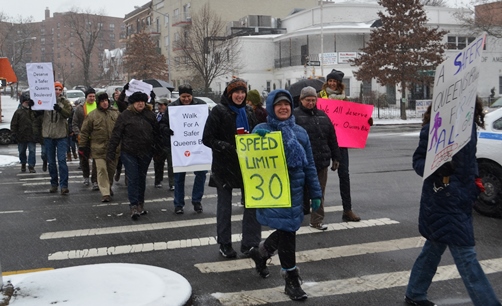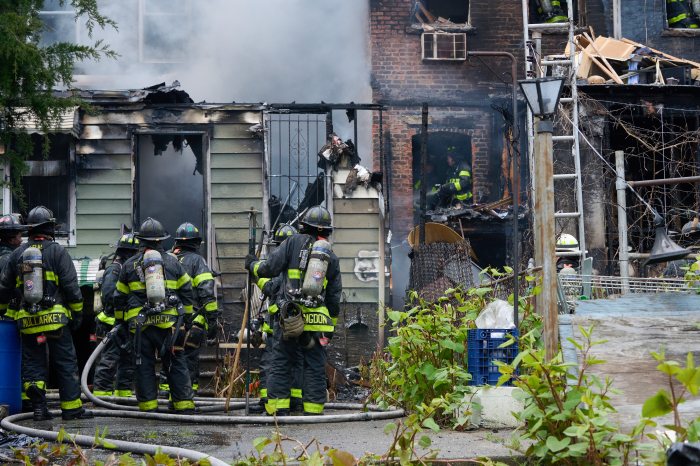Updated, 5:22 p.m
A group of local residents want to make the “Boulevard of Death” a thing of the past.
Regardless of the snow, members of Transportation Alternatives’ (T.A.) Queens Activist Committee and residents gathered Saturday to march down Queens Boulevard during the “Winter Wander” Rally to call for a safer thoroughfare.
The group of advocates, who began the event at New Life Fellowship Church in Elmhurst, spoke about the Zero on Queens Boulevard campaign, calling for a redesign of the strip with pedestrian safety improvements, dedicated lanes for Select Bus Service (SBS) and protected bike lanes.
The snowy march served as the first step in letting people know what they can do to change the busy corridor.
“We’ve been trying to build community support for the city to re-envision Queens Boulevard,” said Jessame Hannus, co-chair of T.A.’s Queens Activist Committee, who carried a sign that read “30 mph” to remind drivers of the speed limit. “We just want to make it clear that this is a neighborhood street and we are all neighbors.”
Hannus said even though many accidents happen on the boulevard, the community just ignores them because they believe it is normal.
According to a “Queens Blvd. Crash Data” map by T.A., there have been 890 pedestrian injuries, 17 pedestrian fatalities, 205 cyclist injuries and 2 cyclist fatalities between 2002 to 2011 on Queens Boulevard stretching from Jackson Avenue in Long Island City to Jamaica Avenue in Jamaica.
“The community doesn’t respond to it,” she said. “It does not have to be this way and it’s not going to change unless we make a fuss about it.”
During the march street safety advocates discussed the history of the roadway, stopping at specific spots pedestrians lost their lives. The “Winter Wander” Rally ended in Forest Hills.
The Zero on Queens Boulevard campaign, with more than 40 coalition partners and close to 2,000 petition signatures, has a long-term goal of making sure the city allocates funding and energy to change the boulevard on a large scale saving lives and strengthening the local economy.
Councilmember Daniel Dromm, who has worked with the Department of Transportation to implement neighborhood slow zones and other pedestrian safety improvements in his district, also joined the group on the march. In his district three children have also lost their lives in traffic fatalities in the past few months.
“This is a very, very serious issue and we have to continue to stress the seriousness of this because sometimes people dismiss it as just something that doesn’t affect their lives but when you look at the statistics you see that there are more pedestrian deaths than there are murders in the city of the New York,” said Dromm. “I believe in the three E’s: engineering, education and enforcement on these issues and that’s what we have tried to do in my council district. More needs to be done.”
According to the DOT, there have been decade-long improvements to the seven-mile strip that have re-engineered the streets for enhanced safety. Some of these improvements include pedestrian countdown signals at more than 60 intersections at Queens Boulevard from Queens Plaza South to Hillside Avenue, lowering the speed limit on Queens Boulevard from 35 to 30 mph, installing 15 electronic boards displaying the speed of passing motorists, installing 46,000 linear feet of pedestrian fencing along the entire corridor to prevent jaywalking and many more.
“Safety is DOT’s top priority, in the last ten years, traffic fatalities have fallen borough-wide by nearly 35 percent,” said DOT spokesperson Nicholas Mosquera. “Queens Boulevard saw 18 pedestrian fatalities at its height in 1997 and zero pedestrian fatalities in 2011, the first time this has been recorded, and two last year along the entire seven-mile corridor. We continue to look for ways to enhance safety both on Queens Boulevard and citywide.”
RECOMMENDED STORIES


































